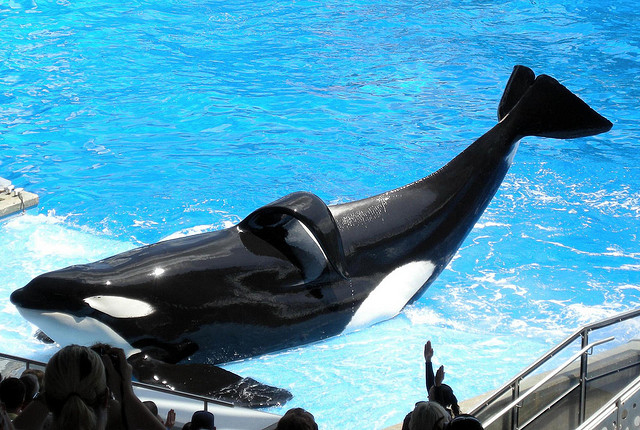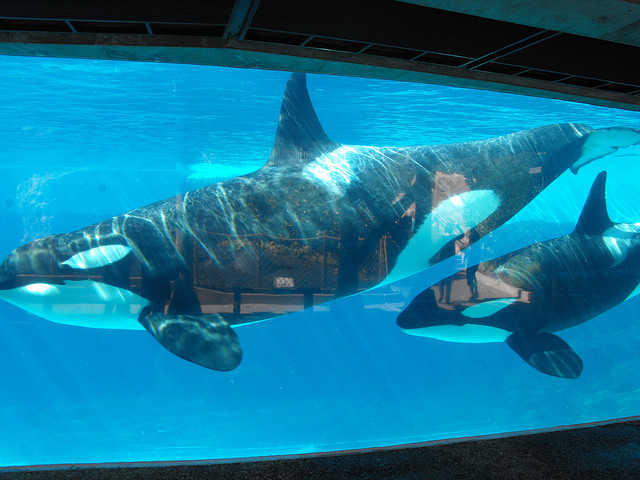Blackfish: A killer documentary
August 28, 2013
“Blackfish” is grim. But then again, so is the plight of these magnificent, intelligent whales.” – Tom Long, Detroit News1
The gripping documentary Blackfish is drawing crowds around the world this summer after advance screenings by Magnolia Pictures in Los Angeles and New York. Notable news outlets from the Guardian to the New York Times have praised the film’s condemnation of animal husbandry and safety practices at SeaWorld, painting a picture of corporate greed and negligence that the multibillion-dollar franchise is now publicly fighting.
Through a mesmerizing and heartbreaking tapestry of firsthand accounts, court proceedings and incident and autopsy reports, Blackfish tells the story of Tilikum, the 12,000-pound orca whale responsible for three human deaths including that of SeaWorld trainer Dawn Brancheau in 2010. Before the film even debuted publicly in July, SeaWorld distributed a “Dear Film Critic” letter to approximately 50 news outlets that it anticipated would review the piece. Calling the film “shamefully dishonest, deliberately misleading, and scientifically inaccurate,” the SeaWorld letter attempted to undermine the credibility of the film with a bullet list of corrections and rebuttals to defend its treatment of killer whales and their trainers.2

Magnolia Pictures and the film’s director, Gabriela Cowperthwaite, refuted SeaWorld’s arguments in a public exchange that has pricked up the ears of the press and an increasingly broad audience. As National Geographic writer Kenneth Brower puts it, “If the film’s producers ever worried about insufficient funds for advertising, they can lay that fear to rest.”3
The controversy stems from Cowperthwaite’s discovery that SeaWorld has used misinformation to make their training and safety practices and the condition of their captive whales appear within the realm of nature. For example, SeaWorld docents and trainers are taught that all orca whales live 25-35 years and sometimes longer in captivity due to good veterinary care. However, studies show that most captive orcas die in their teens and 20’s while wild orcas can live up to 60-90 years.4
Blackfish also calls into question SeaWorld’s treatment of captive orcas with a series of heartbreaking scenes regarding the close quarters within which orcas from different families are forced to cohabitate. As one neuroscientist points out in the film, orcas have highly evolved emotional centers, particularly relating to family bonds. In his National Geographic opinion piece, Kenneth Brower describes how “SeaWorld was built by breaking up killer whale families,” and thus causes great emotional anxiety to the sentient mammals. He continues:
“Every orca colony in every SeaWorld facility began as a kind of orphanage. The founding fathers and mothers in each facility were plucked as calves from their pods, after long chases by aircraft and speedboats tossing bombs, with collateral deaths in nets of siblings and cousins. When Washington State banned SeaWorld from state waters for these practices, SeaWorld moved its collecting operation to Iceland.”3
It doesn’t take a great imagination to understand the emotional and physical damage such treatment could inflict. To make things worse, orcas naturally remain with their mothers throughout their lives. When “Baby Shamu” was shipped to another facility, footage in the film shows how the mother wallowed in the corner and even began making long-distance vocalizations in search of her lost calf. SeaWorld argues that it only separates families “when doing so is in the interest of their long-term health and welfare” but observations of former trainers and handlers say otherwise.2

In short, SeaWorld’s broad condemnation in advance of the Blackfish release focused on minute details while avoiding Cowperthwaite’s overarching message: “Killer whales are 100 percent not suitable to captivity.” In a telephone interview with the NY Times, she continued: “For 40 years, they were the message,” she said, referring to SeaWorld. “I think it’s O.K. to let an 80-minute movie” have its moment.5
Over a month has passed since SeaWorld’s initial confrontation with the makers of Blackfish, and things still seem to be heating up. Just last week, after a deluge of press coverage praising Blackfish and demonstrations outside of SeaWorld facilities, SeaWorld San Diego’s vice president of zoological operations Michael Scarpuzzi published an editorial in the U-T San Diego that evokes the memory of killed trainer Dawn Brancheau in an attempt to vilify the filmmakers as self-serving activists ignorant to the franchise’s conservation efforts.6 Numerous public reactions to the contrary follow the article online.
Could Blackfish turn the tides for orcas at SeaWorld, or better yet, at captive whale programs worldwide? The answer to those questions lies in the continued response of the audience. As a likely Academy Awards contender, Blackfish could inspire a revolution.

Showtimes and more information are available on the Blackfish website. Read more about SeaWorld’s reaction to the film in the sources below, and learn what you can do to take action here.
Featured image (top): Tilikum watches as SeaWorld Orlando trainers take a break during a training session. Photo © Phelan M. Ebenhack/AP
Selected sources:
1. Tom Long (2013) – “Review: ‘Blackfish’ dives into the lives of captive Orcas”
2. Blackfish (2013) – “SeaWorld Bites Back”
3. Kenneth Brower (2013) – “Opinion: SeaWorld vs. the Whale That Killed Its Trainer
4. Mark Carwardine (2001). “Killer Whales.” London: BBC Worldwide Ltd. ISBN 0-7894-8266-5
5. Michael Cieply (2013) – “SeaWorld’s Unusual Retort to a Critical Documentary”
6. Michael Scarpuzzi (2013) – “SeaWorld’s Benefits to Conservation, Research Ignored”







